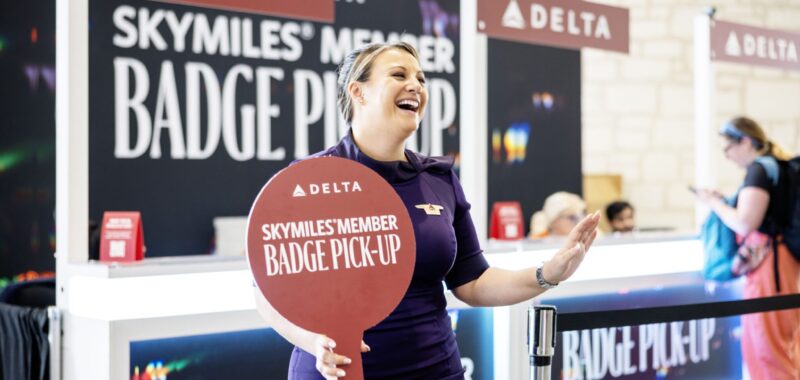Skift Take
Running a profitable airline in the U.S. is increasingly about loyalty, not just logistics. All of the âBig Threeâ lean heavily on frequent flyer programs and co-branded credit cards to help drive revenue – but who came out on top in Q2?
As earnings season draws to a close, weâre taking a closer look at the most lucrative arm of many major U.S. airlines: loyalty programs.
Despite profitability softening and fears of domestic overcapacity, loyalty revenue showed no sign of slowing down in the second quarter. In fact, itâs on track to hit record numbers. To help make sense of it all, weâve examined the performance of each of the U.S. âBig Threeâ carriers.
Delta Air Lines: SkyMiles
When Delta announced sweeping changes to its SkyMiles program in September 2023, the social media backlash was colossal. The changes increased the thresholds for earning status in 2025 and curbed access to Delta’s lounges. This led to concerns among some analysts that membership and revenues could drop as members voted with their feet. Instead, the program has continued to thrive.
In the second quarter, loyalty revenue rose 8% year-on-year to $1.81 billion, cementing the programâs continued success in attracting and retaining members. Delta clocked $1.9 billion from its lucrative deal with American Express in the quarter, up 9% from the previous year.
The result bodes well for its goal of generating $7 billion in revenue from cards alone this year. If realized, this would be a new company record. While impressive, the Atlanta-based firm has an even bigger target in its sights.
Delta CEO Ed Bastian said during the earnings call that he wants to see a âlong-term remuneration goalâ of $10 billion from the program. For context, almost one in three active Delta SkyMiles flyers already carry a co-branded Amex card.
The Delta numbers appear strong, with SkyMiles representing 12% of revenue last year. It’s a high number, but a lower figure than peers including American and Alaska Airlines. At the more extreme end of the scale, Southwestâs Rapid Rewards program and Chase-issued credit card brought in 22% of the low-cost carrierâs revenue in 2023.
As travel demand begins to soften from its post-pandemic peak, Delta is likely to lean more heavily on its loyalty arm to push profitability, justifying expenditure into new premium airport lounges and onboard amenities.
American Airlines: AAdvantage
Americanâs second quarter performance was in the spotlight for all the wrong reasons. The airlineâs profitability was the weakest of the U.S. Big Three and paints a gloomy picture ahead of a crucial renegotiation with credit card partners.
Despite the melancholy mood music, loyalty remains a relative strength for the airline. Itâll be hoping to build momentum in this area as it talks with Citi and Barclays about an even more lucrative new deal.


Although American did not share exact figures, CEO Robert Isom said loyalty revenues rose 8% year-on-year in the second quarter. This mirrored earnings growth at Delta.
The airline revealed that 74% of premium cabin revenue came from loyalty members, with total spending on co-branded cards rising by âdouble-digits.â This suggests that even with potential overcapacity issues in domestic and short-haul international markets, American can rely on strong card remuneration.
American is said to be close to finalizing its card negotiations with Citi and Barclays. If former chief commercial officer Vasu Rajaâs comments are anything to go by, revenues from financial products are set to rise further still.
Speaking exclusively to Skiftâs Airline Weekly Lounge podcast earlier this month, Raja noted: âThe highest margin carriers that are out there typically have a couple of things in common⦠theyâre sourcing letâs call it 15% of their revenue just from the line items called frequent flyer.â
However, some analysts have raised doubts about how hard American can push amid a widening gap with United and Delta, both of whom have exclusive bank partnerships.
United Airlines: MileagePlus
It was another strong quarter for United Airlines, with MileagePlus leading the charge with a 13% increase in revenue. The result came as the carrier entered a Q3 where it expects to see a drop in capacity and earnings. Q1 2024 saw a 15% rise in loyalty revenue, pointing to a strong year for Unitedâs Chase co-branded card and loyalty members.
While Delta and American focused on card remunerations during Q2 earnings calls, Unitedâs leadership did not dwell on the topic. However, with MileagePlus making around 10% of Unitedâs 2023 revenue â the lowest percentage among the U.S. top five carriers â the airline still has room to grow. Its current deal with Chase and Visa runs until 2029 and was signed just weeks before the pandemic took hold.
In other loyalty developments, United revealed last month that it has repaid a large Covid-era loan earlier than expected. The carrier entered a $1.8 billion agreement leveraged against the MileagePlus program during the pandemic. This loan highlighted the programâs valuation of $20 billion in 2020, aided by over $1.8 billion in profit and $5.3 billion in cash flow for the airline in 2019.
A Future Built on Loyalty?
Itâs no secret that the three largest airlines, particularly United and Delta, have managed to come out on top of low-cost rivals in recent months. While the likes of Spirit and Frontier have posted disappointing results, diversified revenue streams from loyalty and card partnerships have allowed network carriers to pocket billions each year.
Unsurprisingly, many budget airlines are keen to grab a slice of the action. Loyalty portfolios are being steadily overhauled, with lucrative financial products and high-margin ancillary services becoming a bigger part of the business model.
For now, expect to see results skew towards the established market leaders. However, there are concerns that loyalty programs of the biggest U.S. airlines have grown so huge that smaller carriers canât compete. It’s a topic that recently attracted federal scrutiny, and is certainly one to watch.
Airlines Sector Stock Index Performance Year-to-Date
What am I looking at? The performance of airline sector stocks within the ST200. The index includes companies publicly traded across global markets including network carriers, low-cost carriers, and other related companies.
The Skift Travel 200 (ST200) combines the financial performance of nearly 200 travel companies worth more than a trillion dollars into a single number. See more airlines sector financial performance.
Read the full methodology behind the Skift Travel 200.

